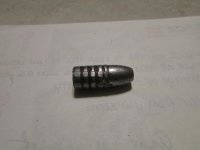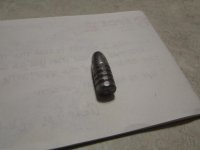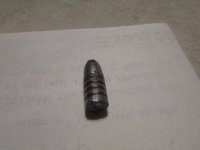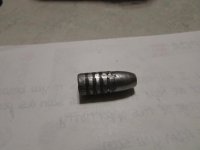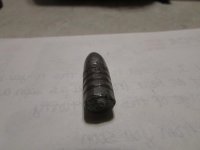I have a number of old Winchester 1894s in 38-55 and have been reloading for them for a long time. My current project is one I posted about a few weeks ago and it poses a challenge when it comes to reloading. It is a reservation gun that was once a special order rifle, circa 1900. It has a button magazine. I finally got around to slugging the barrel and learned a bit why it was parted out. The first 6"s of the barrel at the muzzle engaged the slug and cut rifling grooves in the soft lead and then it dropped into the abyss. This was with a .379 cast bullet. My question is should I acquire a few samples of .380 cast slugs in order to engage what may be left of its rifling. This is an early barrel without any markings except for the patient dates and caliber. I have attached 5 photos of the cast bullet used in the slugging process. It engages well before exiting the muzzle. Your thoughts are appreciated.
-
Forum Update: We've upgraded the software to improve security, performance, and the overall experience.
👉 Read why we made the change | Support the Forum
You are using an out of date browser. It may not display this or other websites correctly.
You should upgrade or use an alternative browser.
You should upgrade or use an alternative browser.
Reloading For The Winchester 1894, 38-55
- Thread starter delta-419
- Start date
Register to hide this ad
Ivan the Butcher
Member
My 38-55 is a Modern 1885 Winchester and the barrel is .375". I inherited a friend's ammo for his BP and old lever actions. His handloaded 38-55's were with .388 bullets and won't chamber in any other 38-55 I have tried.
Before I would invest in a box of 255 grain bullets, I would scrounge up some round balls and slug the barrel from the chamber for 6 or 8 inches. Then buy bullets bases on that end.
Ivan
Before I would invest in a box of 255 grain bullets, I would scrounge up some round balls and slug the barrel from the chamber for 6 or 8 inches. Then buy bullets bases on that end.
Ivan
rockquarry
Member
- Joined
- Aug 9, 2005
- Messages
- 8,516
- Reaction score
- 10,463
Don't waste your time slugging the barrel. Shoot the largest diameter bullet that will allow chambering a loaded cartridge without difficulty. .38-55 bores vary far more than most other cartridges.
max503
Member
Yes. I would try a .380" diameter lead boolit. But with that much freebore I think there will be problems with skidding. The rifling marks will smear before the grooves engage and spin the projectile.
I wonder what the diameter of the freebore section is?
Why would they have made it like that?
I wonder what the diameter of the freebore section is?
Why would they have made it like that?
Last edited:
rockquarry
Member
- Joined
- Aug 9, 2005
- Messages
- 8,516
- Reaction score
- 10,463
Wouldn't you want to size projectiles to fit the smallest groove diameter for safety? That would be (in this case) a thousandths or two over the groove diameter of the last 6 inches of barrel?
I don't understand what you are saying...one or two thousandths over groove diameter is probably where you will wind up with my suggestion. What does the last six inches of the barrel have to do with anything? That's not meant disparagingly; I don't follow the reasoning.
max503
Member
I don't understand what you are saying...one or two thousandths over groove diameter is probably where you will wind up with my suggestion. What does the last six inches of the barrel have to do with anything? That's not meant disparagingly; I don't follow the reasoning.
Something squirrely is going on with that rifle. That rifled section could act as a constriction if you tried to shoot a projectile that is too big.
I would do a chamber casting and I would slug the "abyss" as well.
Last edited:
rockquarry
Member
- Joined
- Aug 9, 2005
- Messages
- 8,516
- Reaction score
- 10,463
Something squirrely is going on with that rifle. That rifled section could act as a constriction if you tried to shoot a projectile that is too big.
I would do a chamber casting and I would slug the "abyss" as well.
I see what you're talking about now. Do a Cerrosafe casting of the area in front of the beginning of the rifling and get the first half-inch or more of the rifling, if possible.
twodog max
Member
I have a NOE mould that drops bullets at .382 with some alloys. If you feel the need for a big bullet PM me and I will make a couple from pure lead for you.
twodog max
Member
The 38/55 is a fun shooter but bore sizes are all over the map.
OP
Luck of the Irish
I stopped at a yard sale and on one of the tables was a box of 38-55 LBT style heat treated solids cast bullets with a gas check. A count of 100 bullets 260gr sized .380 for $35. They were made by Cast Performance Bullet Company. I hope these will be the magic load for this old Winchester. I have the first 20 in the loading block and might start with Trail Boss 6.5gr. Will a gas check make a difference?
I stopped at a yard sale and on one of the tables was a box of 38-55 LBT style heat treated solids cast bullets with a gas check. A count of 100 bullets 260gr sized .380 for $35. They were made by Cast Performance Bullet Company. I hope these will be the magic load for this old Winchester. I have the first 20 in the loading block and might start with Trail Boss 6.5gr. Will a gas check make a difference?
rockquarry
Member
- Joined
- Aug 9, 2005
- Messages
- 8,516
- Reaction score
- 10,463
I stopped at a yard sale and on one of the tables was a box of 38-55 LBT style heat treated solids cast bullets with a gas check. A count of 100 bullets 260gr sized .380 for $35. They were made by Cast Performance Bullet Company. I hope these will be the magic load for this old Winchester. I have the first 20 in the loading block and might start with Trail Boss 6.5gr. Will a gas check make a difference?
Quite often, a gas check design will be more accurate with a gas check affixed, but that depends on many factors. If you have the checks and a sizer that will crimp the check on the bullet base, try some loads with and without gas checks. Shooting some groups from a benchrest at 50 or 100 yards will tell you what you want to know. May shoot fine without the checks.
twodog max
Member
Never tried gas check in the 38/55 but have in my 45/70's. Honestly do not see much accuracy difference if any. Leading in the rifles that do so may be less.
I am no cast bullet expert but I would think if your bore is oversize the gas check might not do as well but only one to know load them up and shoot.
Mike Venturino mentions Marlin rifles with bores as big as .384 if I recall correctly.
The is a You Tube video that describes problems with a Model 94 with a varying bore. A newer 94.
Like I mentioned before 38/55 are all over the place with bore size.
I am no cast bullet expert but I would think if your bore is oversize the gas check might not do as well but only one to know load them up and shoot.
Mike Venturino mentions Marlin rifles with bores as big as .384 if I recall correctly.
The is a You Tube video that describes problems with a Model 94 with a varying bore. A newer 94.
Like I mentioned before 38/55 are all over the place with bore size.
N-frame-guy
Member
Wondering how the OP made out with this project? My old W94 also has a very worn bore. After much experimenting, I ended up with .382 bullets from Rimrock in Starline brass. They are a plain base bullet, no gas checks. They wouldn't chamber using standard Winchester brass, too fat. My RCBS dies also won't crimp them due to the diameter so I had to get a Lee FCD to put the squeeze on them for running through the magazine. About 9 grains of Unique and I've got a fun plinker in a 2nd year production rifle.

